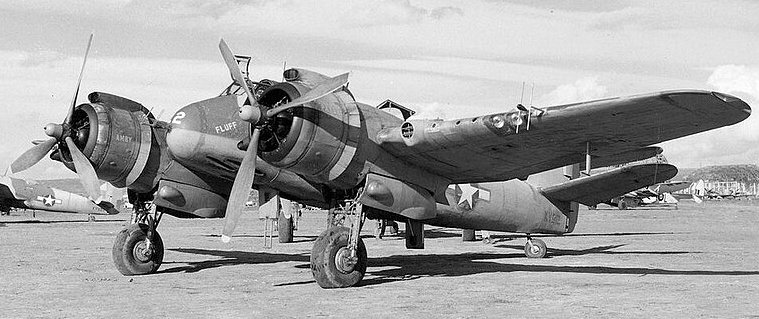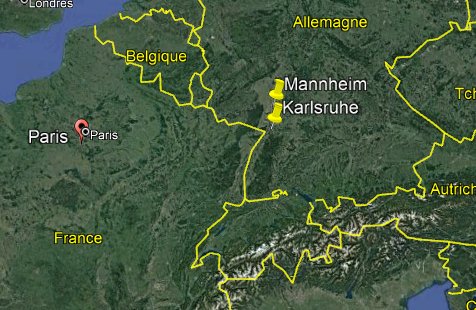ACUFO-1944-12-17-KARLSRUHE-1
In 1998, ufologist Barry Greenwood, leading figure of the Citizens Against UFO Secrecy (CAUS) presented one of the declassified documents he obtained.
It was the Mission Report of the 415th Night Fighter Squadron of the U.S. Army Air Forces for the night from December 17 to 18, 1944.
Among the “Foo Fighter” cases of that night, there was one that occurred on a mission in the Karlsruhe - Mannheim area from 05:25 p.m. to 07:20 p.m., under a 10/10 clouds at 7500 feet and a visibility of 1 mile.
The ground radar station codenamed “Churchman” vectored the night fighter to a target at 06:55 p.m., for a head on interception, but the plane [p]assed the target and contact was lost. The plane later saw one rocket [it could only have been a V-2], they saw a scant light at a place called 2R-1363, but no enemy air traffic was sighted.
| Date: | December 17, 1944 |
|---|---|
| Time: | 06:55 p.m. |
| Duration: | ? |
| First known report date: | December 18, 1944 |
| Reporting delay: | Hours, 1 day. |
| Country: | Germany |
|---|---|
| State/Department: | Baden-Wurtemberg |
| City or place: | Karlsruhe, Mannheim |
| Number of alleged witnesses: | ? |
|---|---|
| Number of known witnesses: | ? |
| Number of named witnesses: | 0 |
| Reporting channel: | Military mission report. |
|---|---|
| Visibility conditions: | Night. |
| UFO observed: | Yes. |
| UFO arrival observed: | ? |
| UFO departure observed: | ? |
| UFO action: | |
| Witnesses action: | |
| Photographs: | No. |
| Sketch(s) by witness(es): | No. |
| Sketch(es) approved by witness(es): | No. |
| Witness(es) feelings: | ? |
| Witnesses interpretation: | ? |
| Sensors: |
[ ] Visual: No.
[X] Airborne radar: No. [X] Directional ground radar: Yes. [ ] Height finder ground radar: [ ] Photo: [ ] Film/video: [ ] EM Effects: [ ] Failures: [ ] Damages: |
|---|---|
| Hynek: | ? |
| Armed / unarmed: | Armed, four 20 mm cannons and 6 7.62 mm machine guns. |
| Reliability 1-3: | 3 |
| Strangeness 1-3: | 1 |
| ACUFO: | Low strangeness. |
[Ref. bgd1:] BARRY GREENWOOD:
In 1998, US long time researcher Barry Greenwood provided declassified U.S. Army Air Force documents he obtained patiently using the Freedom Of Information Access law (FOIA) to the Computer UFO Network (CUFON). Barry Greenwood was for many years the Editor of the bulletin Just Cause and co-author of the book "Clear Intent", and the editor of the U.F.O. Historical Review which debuted in June 1998.
MISSION REPORT
UNIT REPORTING: 415th Night Fighter Squadron
INTRUDER MISSIONS: 4 Missions 4 Sorties DATE: Dec. 17/18
REPORT:
1. 1725-1920 - Karlsruhe - Mannheim area. 10/10 clouds at 7500 ft, visibility 1 mile. vectored onto bogie by Churchman at 1855 hours - headon interception, passed each other and lost contact. Flak: Moderate, heavy at R-4980, R-3968, R-3146; scant, light at R-1363; 1 rocket at R-5699. No traffic sighted.
[... other cases...]
CLAIMS
Motor Transport
Destroyed 9
Damaged 18
Losses
None
The Bristol Type 156 “Beaufighter”, nicknamed “Beau”, was a British multi-role aircraft developed during WWII. It was originally conceived as a heavy fighter variant of the Bristol Beaufort torpedo bomber; it proved to be an effective night fighter, which came into service with the Royal Air Force (RAF) during the Battle of Britain.
Originally, armament consisted of four 20mm cannons and six 0.303-in machine-guns but many variants were built; for example, versions had the ability to additionally carry eight rocket projectiles, some had a Vickers 'K' gun, Beaufighter TF.Mk X was used for anti-shipping operations.
The Beaufighter Mk VIF was fitted with the Mark VIII radar.
Below: Beaufighter Mk VIF of the 415th Night Fighter Squadron.

|
The Beaufighters served with the U.S. Army Air Forces until the end of the war, but most were replaced by the P-61 “Black Widow” beginning on March 20, 1945.

|
It is not obvious that Barry Greenwood thought this sighting among the other in the mission report was odd, there is no evidence that the crew did.
The usual procedure in the night fighters operations of 415th NFS was as follows:
The ground radar station (CGI) would scan the skies, and if a suspicious echo was detected, they would vector the nearest available night fighter plane in flight to a position 7 miles behind that target. The night fighter would then use its onboard radar (AI) to track the target and attack it.
Here it seems that the oddity is that the ground radar gave a target to a night fighter plane, that night fighter plane tried a head on intercept, but did not get any contact with the target, i.e., apparently, they did no detect it on their radar and did not see what it was, whereas the ground radar still tracked it.
It is of course impossible to explain why in any detailed manner; but it is of course possible that the AI radar simply malfunctioned.
Low strangeness.
* = Source is available to me.
? = Source I am told about but could not get so far. Help needed.
| Main author: | Patrick Gross |
|---|---|
| Contributors: | None |
| Reviewers: | None |
| Editor: | Patrick Gross |
| Version: | Create/changed by: | Date: | Description: |
|---|---|---|---|
| 0.1 | Patrick Gross | November 17, 2023 | Creation, [bgd1]. |
| 1.0 | Patrick Gross | November 17, 2023 | First published. |